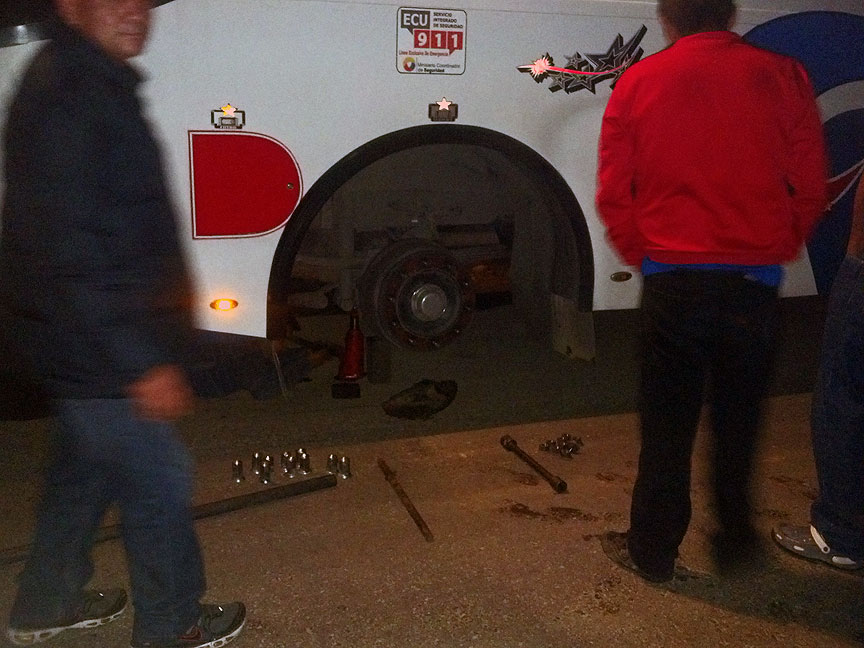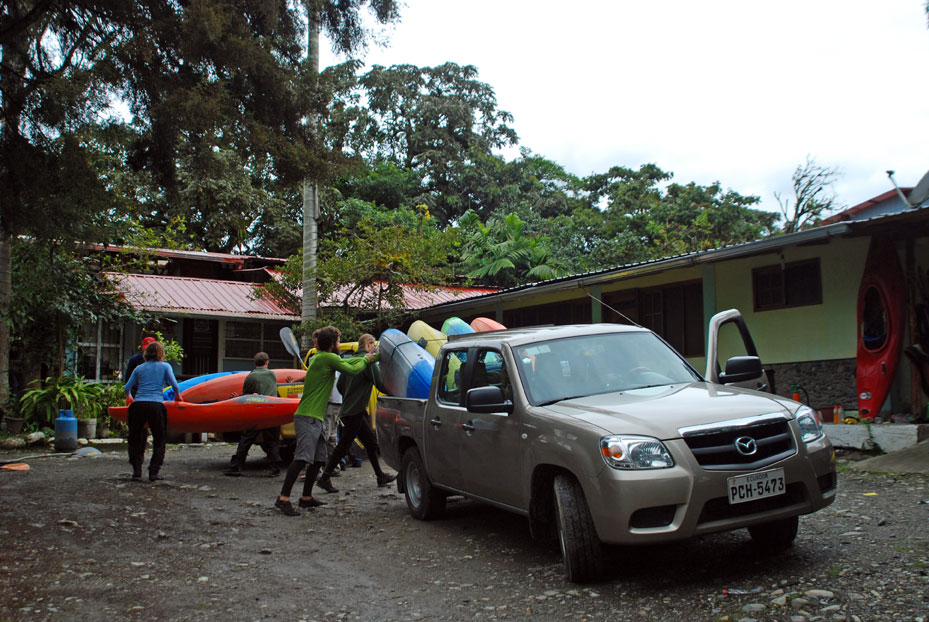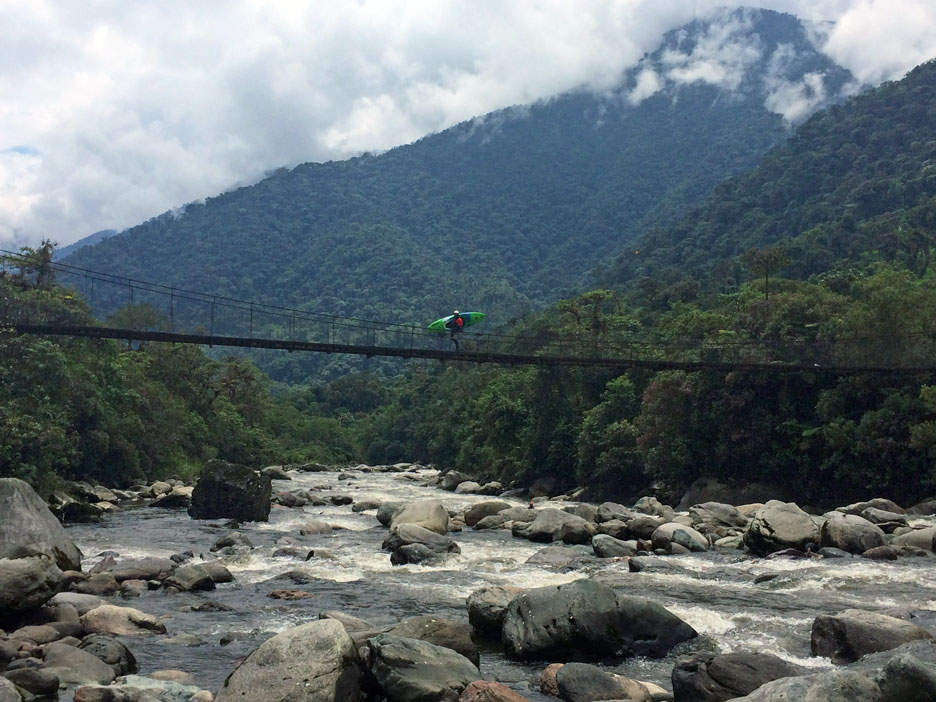 We stumbled out of the airport, sleep deprived and more than three hours behind schedule, awkwardly weaving an unwieldy cart loaded with two kayaks, a paddle bag, and a mound of gear through the crowded obstacle course of the baggage claim area. We had left our house in NC about 26 hours earlier, the travel becoming a blur of highway miles, taxi rides, lengthy layovers, plane flights, connections, customs clearance, and a weird detour to the airport in a southern Ecuadorian town we’d never even heard of, where we spent two nervous hours in travelers’ limbo on the tarmac before finally flying on to Quito, Ecuador.
We stumbled out of the airport, sleep deprived and more than three hours behind schedule, awkwardly weaving an unwieldy cart loaded with two kayaks, a paddle bag, and a mound of gear through the crowded obstacle course of the baggage claim area. We had left our house in NC about 26 hours earlier, the travel becoming a blur of highway miles, taxi rides, lengthy layovers, plane flights, connections, customs clearance, and a weird detour to the airport in a southern Ecuadorian town we’d never even heard of, where we spent two nervous hours in travelers’ limbo on the tarmac before finally flying on to Quito, Ecuador.
As we wheeled our ungainly cart out of the airport and into the Ecuadorian morning sunshine, I spotted a man holding up a hand-scrawled sign with a strange but phonetically approximate rendition of my name. With our kayaks and gear in our possession and our ride to whitewater paradise still waiting for us after all of our delays, it was finally time for vacation to begin!

Most of my paddling trips to new destinations have been explorations undertaken behind the wheel with maps in hand and a keen sense of adventure in mind. It’s the image that much of the paddling media promotes—a group of kayakers on a “mission” or an “expedition” to run some obscure river in a far away land. Their photos and videos are filled with coverage of trying to make it to the river, epic shots of getting their vehicles out of the mud, and other images of trials and misadventures. But what if your purpose for traveling is to take a break from the challenges that you face everyday in the non-paddling world? What if you want to leave all of the drama behind and go on a paddling trip that is truly a vacation? We found just such a destination in Ecuador. Here’s what makes it the perfect spot to get away for some whitewater fun, and some things to consider when setting out on any paddling vacation.
Ease of Travel

The most daunting hurdle on many foreign paddling trips is simply getting from the airport where the rivers are. In Ecuador, travel from the airport to your hotel in Baeza or Tena, the two main paddling towns—or back and forth from one to the other—is as easy as hopping in a cab or on a bus. A two or three hour drive will take you from the airport in Quito to Baeza, or from Baeza down to Tena. The bus costs about five dollars per person with your kayak, and the taxi is roughly $80 – $100 for up to four people and four boats. We chose to use taxis for the rides to and from the airport, which we arranged through Hostal la Casa de Rodrigo in Baeza. We used buses for our travels between Baeza and Tena. The biggest epic we got into while traveling from town to town was a flat tire on the bus late at night. Other than that, it was incredibly simple to jet around Ecuador hauling a kayak with a minimum of fuss.

Ease of Shuttle

Not only is it simple to get from town to town in Ecuador, but the ease of transportation extends to getting to and from the river. Both Baeza and Tena have numerous taxis—compact pickup trucks with full back seats that can haul up to five people and five boats. What’s more, the drivers are usually well versed in the locations of the put-ins and take-outs. We did no fumbling with maps and had very few wrong turns as we rode in style to and from the rivers every day. If you have some rudimentary Spanish skills and a local cell phone, you can call a taxi and arrange a ride to the river each morning. The drivers will keep your dry clothes safe in the cab and pick you up at the take-out at a prearranged time. With all of the logistics handled for you, there is nothing left for you to think about except for relaxing and enjoying the river.
Quality Moderate Whitewater

While paddling expeditions to run obscure Class V rivers can be exhilarating, there’s a lot to be said for trips where you don’t get that fight-or-flight knot in your gut every day on the river. After all, it’s supposed to be a vacation. Ecuador has a nearly limitless supply of whitewater in the Class III to IV+ range, allowing intermediate to expert paddlers to get plenty of thrills with relatively few chills and spills. “Fun factor over fear factor” is the motto for a trip there, and really for most any paddling vacation where relaxation is more important than pushing your limits. The concentration of quality whitewater around Baeza and Tena is astonishing.

Variety of Whitewater
It’s easily possible to paddle big water one day and a quality creek the next while staying in either Tena or Baeza. Densely packed drainages combine with extreme elevation changes and abundant tropical rainfall to create rivers of all shapes and sizes in Ecuador.


Ease of Lodging

Just like every other aspect of traveling as a paddler in Ecuador, the lodging options are ridiculously easy. In both Baeza and Tena there are multiple hostels that range in price and quality from the rough equivalent of raft guide housing to very nice family establishments. Almost all of them have some sort of enclosed courtyard where boats and gear can be stored without fear of theft, and a covered space where equipment can be hung to dry. In Baeza we stayed at the comfortable and clean Hostal la Casa de Rodrigo, and in Tena we used La Posada and Welcome Break. The other great thing about staying in these paddler-friendly hostels is that there are always other paddlers there to hook up with for rivers and to share shuttles.

Warm Weather

If you look at a lot of paddling media, you’ll see tons of photos and videos of boaters waking up to frost on their gear or battling the elements in their drysuits. While quality gear can make nasty weather conditions less painful, there’s something to be said for taking a relaxing vacation from the elements and enjoying some warm weather and warm water while paddling in a shorty. In my month in Ecuador, I didn’t wear anything heavier than a light pair of Hydroskin pants and a drytop with one thin layer under it. I only wore the drytop two or three days, and some of those days I was too hot.
Mind Boggling Scenery

The landscape in Ecuador is incredible, with the tallest mountain range of the Americas thrusting up through a lush layer of tropical jungle. One of the reasons that we travel to paddle new rivers is to interact with different amazing landscapes, and Ecuador did not disappoint.


Variety of Culture, Weather and Scenery
One of the most fun parts of a foreign paddling trip is getting to experience other cultures and landscapes. In Ecuador, you can experience two totally different social and natural environments with a minimum of hassle and danger. Although they are geographically close together, Baeza and Tena have markedly different flavors in terms of weather, culture and scenery. Although there is some risk of theft in Tena. the larger of the two, both are safe places to travel as a gringo.

Baeza is a sleepy mountain town. Three kayaker-friendly hostels are situated in the old village, with hardly anybody else around. The weather is cool and misty, and the rivers are generally a touch harder than the ones down the hill in Tena. There is a bus stop at the corner just across from the hostels that will take you easily to Quito or to Tena when you get tired of what Baeza has to offer.

Tena is a hopping small city filled with loads of options for eating out and enjoying culture and nightlife. The weather is sweaty hot, and the jungle on the surrounding hills is a dense, lush green. The whitewater around Tena has more intermediate options than Baeza, but also a few fun creeks to keep the challenge up if that’s what you want. After paddling, you can get an enormous filet mignon in town for $11, have drinks at a bar on the banks of the river in downtown, or go out for ice cream. When you get tired of the bustle of Tena and want to head back to Baeza to mellow out, the bus stop is only two blocks away from the hostels.


Our month in Ecuador was a departure from our usual style of trip, a step outside the reality of our everyday environment. It was also a safe and easy trip that left us feeling refreshed and relaxed instead of coming home with sore bodies and frazzled nerves. The whitewater was fun without being fear inducing, and the travel was sufficiently simple to allow us the adventure and excitement of new and different experiences without the obstacles usually inherent with being a traveler in a foreign land. It wasn’t just a paddling trip, it was a true paddling vacation—and a lesson in the things to look for on future trips to escape the rigors of the day-to-day. Here’s hoping you find your ultimate vacation-paddling destination as well.